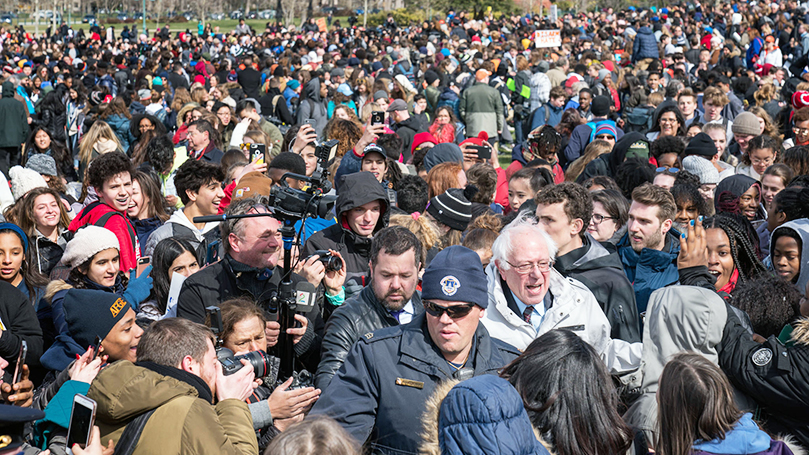
I was struck by a headline I stumbled across on Facebook the other day that claimed “Bernie Sanders is not the left,” based on the apparent hesitation of Sanders to take a position supporting abolishing ICE, favored in New York not only by DSAer Alexandria Ocasio-Cortez, the winner of the historic Democratic primary in the Bronx and Queens last month, but also by the centrist presidential hopeful Sen. Kirsten Gillibrand, D-N.Y.
Apparently, Sanders’s cautiousness with regard to what his critics deem a clear-cut democratic and human rights issue is enough to cast him outside the pale. But is that fair? It’s an important question complicated by the manner in which right, left, and center is determined in U.S. politics.
Historically, the terms left and right emerged out of the French Revolution’s National Assembly: those sitting on the right supported the King; those on the left, the revolution. Fair enough: Reaction to the right and democracy and revolution to the left. But in our country this clear divide is obscured by the portrayal of these terms as cultural issues. Stances taken on questions like gun control, reproductive rights, drug legalization, health care, the role of government, immigration, and standing for the national anthem, to mention only a few, are posed as the battlelines around which the country’s cultural wars are waged between the conservative right and the “liberal” left.
But each of these issues go beyond cultural matters. They are also political, social, and economic. Behind them lie interests and motives that in large measure determine where folks lineup in the battles taking place across the breadth and width of the land.
Health care is a good example. The big hospital and pharmaceutical corporations are on the right side of this question: They oppose even partial measures like Obamacare’s provision on pre-existing conditions because it affects their profit margin. Unions and civil rights groups, on the other hand, lie squarely on the left: Workers benefit because the corporations are compelled to shoulder a larger part of the cost for healthcare, leaving more money in the pockets of those that need it most.
The same can be said for most every issue on which left and right line up.
Issues that benefit big business generally end up on the right wing side of things; those that benefit the working class, are on the left.
Thus, another and more accurate way of assessing left or right is to judge how an issue in question affects class interests. Issues that benefit big business generally end up on the right wing side of things; those that benefit the working class, are on the left.
Government regulation is another good example of this. Corporations favor less regulation because they don’t want rules governing the environment or worker health and safety to get in the way of profits. That’s why Wall Street and the Chamber of Commerce – mainly but not exclusively – support the Republican Party: It’s in their class interest to do so.
But what about issues like abolishing ICE? Here too class interests are involved. A working-class and therefore left position would favor abolishing ICE as part of program of comprehensive immigration reform and a path to citizenship. Why? Not only because it’s morally right, but also because so long as immigrant workers are not citizens, they can be more easily exploited by paying them less and denying them benefits.
So why the cautiousness on the part of Sanders when it comes to getting rid of ICE, which is essentially a deportation agency? Here, it’s not so clear cut. It could be that a determination was made that opposing ICE would help the GOP among some working and middle class white voters caught up in Trump’s anti-immigrant hysteria. The thinking here is that the stakes in the midterm elections are so high that alienating even a fraction of potential Democratic voters is an error: A winning coalition must be achieved at all costs.
It’s an arguably reasonable position. But what it fails to understand is that the victims of racism are part of this winning coalition. Given the horrors on the U.S.-Mexican border and ICE’s role in separating families, will voters so affected come to polls if their electoral advocates fail to address these issues?
Fighting racism is key to achieving the electoral class unity needed to defeat the extreme right.
Fighting racism is key to achieving the electoral class unity needed to defeat the extreme right, particularly now. Normalizing racist police tactics, whether on the border or in urban communities, only contributes to the growing fascist danger. A working-class left approach would see that ICE is tearing families apart and that racism is dividing the class. The left must help those workers confused by Trump to see how their interests also line up with abolishing ICE. If not us who?
A section of the left that narrowly understands class has not understood the need to address such fundamental issues. The issue then is to understand the reasons that lay behind the kind of cautiousness supposedly expressed by Sanders. Taken by itself, caution is neither right nor left. In fact, caution could very well be a sign of maturity and revolutionary wisdom. However, if it’s connected to a non-struggle approach to workers influenced by Trump, it moves away from consistent left positions. Truth be told, this approach affected the outcome of the 2016 campaign.
That said, what of the notion that Sanders is not “the left?” Here, the Communist Party has argued that a broad left exists in the U.S. that is anti-corporate, pro-union, anti-sexist, pro-environment, pro-health care, anti-racist and pro-LGBTQ rights. Sanders, who describes himself as a democratic socialist, is clearly in this camp. On the other hand, coming out of the non-Marxist social democratic left, he’s taken some positions which are not consistently pro-working class – that does not, however, cast him or those like him outside of left circles. The middle-class liberal left, when put under pressure, has a tendency to move to the right.
In such cases, it’s vitally important to avoid a sectarianism that pushes away erstwhile allies, recognizing that in political life, there’s the appearance of leftness on the one hand (always being bold, militant, and uncompromising), and real leftness on the other (judging every set of circumstances individually, assessing when to be bold or cautious, and deciding whether to be uncompromising or flexible).
Hence, a working-class approach suggests the need to work together on issues where there’s agreement and continuing to discuss and debate where there’s not.
“The left,” consists of organizations and individuals who are consistently pro-working class.
In such a manner, “the left,” which we would define as organizations and individuals who are consistently pro-working class, can only grow in strength and influence.
This pro-working class left today is being formed in unique circumstances. It is taking shape in conditions of wage stagnation, enormous student debt, extreme inequality, economic instability, and potentially existential environmental threats. It is a left coming of age in the fight against racism, anti-immigrant nationalism, gross sexism, and a massive attack on democratic institutions.
It is a left that sees socialism as deeply democratic and egalitarian; sees health care, education, housing, and jobs as basic rights; and believes in the need for people’s control from below over every aspect of their own lives.
It is a left that must see the fight against racism as central to defeating the right.
It is a social media and social network-organized left being forged in the cultural wars and the battle for truth. And at bottom, behind these cultural wars are class wars and class interests. If you’re uncertain where you stand, just ask, who benefits? If it’s the ruling class, you end up on the right; if it’s the working class, congratulations, you’re on the left!


 Join Now
Join Now